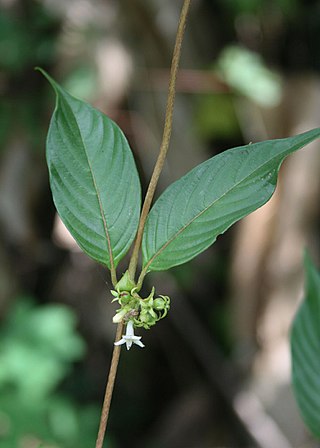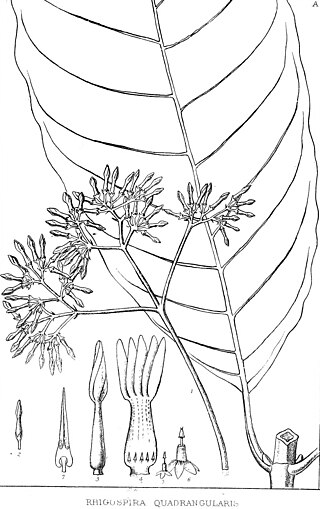
Quassia is a plant genus in the family Simaroubaceae. Its size is disputed; some botanists treat it as consisting of only one species, Quassia amara from tropical South America, while others treat it in a wide circumscription as a pantropical genus containing up to 40 species of trees and shrubs.

Gentianaceae is a family of flowering plants of 103 genera and about 1600 species.

Chrysobalanaceae is a family of flowering plants, consisting of trees and shrubs in 27 genera and about 700 species of pantropical distribution with a centre of diversity in the Amazon. Some of the species contain silica in their bodies for rigidity and so the mesophyll often has sclerenchymatous idioblasts. The widespread species Chrysobalanus icaco produces a plum-like fruit and the plant is commonly known as the coco plum.

Sabicea is a genus of flowering plants in the family Rubiaceae. They are known commonly as the woodvines. The type species is Sabicea cinerea. There are about 145 species. Most are distributed in tropical Africa and South America.

Xylopia frutescens is a tree species the genus Xylopia and family Annonaceae and its native range is S. Mexico to S. Tropical America.

Rauvolfioideae is a subfamily of the flowering plant family Apocynaceae. Many species are woody lianas, others are shrubs or perennial herbs.

Rhigospira is a genus of flowering plants in the family Apocynaceae, first described as a genus in 1878 by John Miers. The species, Rhigospira quadrangularis was first described as Ambelania quadrangularis by Johannes Müller Argoviensis in 1860 but was transferred to the genus, Rhigospira, in 1878 by John Miers. The genus contains only one known species, Rhigospira quadrangularis, native to northwestern South America.

Matourea is a genus in the family Plantaginaceae. It is found in South America. It is the correct name for former genus Achetaria that contained ten species.
Votomita is a genus of flowering plants belonging to the family Melastomataceae.
Touroulia is a genus of flowering plants belonging to the family Ochnaceae.
Ticorea is a genus of flowering plants belonging to the family Rutaceae.
Tamonea is a genus of flowering plants belonging to the family Verbenaceae.

Coussapoa is a genus of flowering plants belonging to the family Urticaceae.
Coutoubea is a genus of flowering plants belonging to the family Gentianaceae.
Maripa is a genus of flowering plants belonging to the family Convolvulaceae.

Matayba is a genus of flowering plants belonging to the family Sapindaceae.
Norantea is a genus of flowering plants belonging to the family Marcgraviaceae.
Pacouria is a genus of flowering plants belonging to the family Apocynaceae.
Piparea is a genus of flowering plants belonging to the family Salicaceae.
Zanthoxyloideae is a subfamily of the family Rutaceae.










